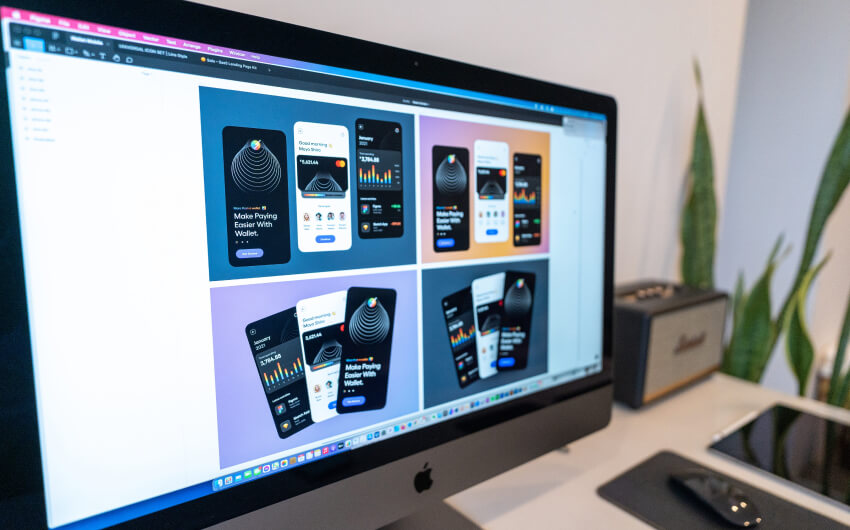Design
UX researcher vs UX designer: what's the difference and why it matters
Learn the difference between UX researchers and designers to ensure digital product success. This post clarifies their roles, importance, and offers tips for hiring and understanding UX. Let's uncover the secrets of these essential roles together.

1. Introduction
Roles of UX researchers and UX designers
UX designers and researchers play different but equally crucial responsibilities in UX design. Through a variety of research techniques, including surveys, interviews, and usability testing, UX researchers focus on understanding users' needs and behaviors. In order to create user personas, user journeys, and other user-centered design artifacts, they examine the data collected from these investigations. On the other hand, it is the job of UX designers to transform these user insights into appealing and understandable user interfaces that support company goals. To produce wireframes, prototypes, and high-fidelity designs that match user needs and behaviors, they use design tools and techniques.
Confusion or misunderstandings about the difference between these roles
Despite the clear differences between UX researchers and UX designers, there are still some common misunderstandings or misconceptions about their roles. For example, some people may think that UX researchers only conduct surveys or that UX designers only make things look pretty. These oversimplifications can lead to underestimating the importance of each role and result in a suboptimal user experience.
Clarifying the difference and why it matters for startups
Understanding the distinction between UX researchers and UX designers and why it matters is essential for entrepreneurs. Startups can better understand their target customers by using UX research to create offerings that respond to their needs. Increased client satisfaction, loyalty, and revenue could come from this. On the other side, UX design makes sure that the product or service is aesthetically pleasing and simple to use, which results in a better user experience and higher engagement.
By providing a better user experience, startups that invest in both UX research and UX design can gain an advantage over their competitors. Startups can more effectively accomplish their business objectives and make better choices about their UX design approach by defining the differences between these roles and understanding the value of each one.
2. The role of UX researchers

Definition and core responsibilities of UX researchers
UX researchers are experts who focus on comprehending consumers' requirements, actions, and attitudes around digital products and solutions. They are in charge of carrying out research studies and collecting data to guide the design process and guarantee that the final product or service satisfies user requirements. Some of the primary duties of UX researchers include the following:
- Conducting user research studies: To obtain knowledge of user demands, behaviors, and pain spots, UX researchers plan and carry out research projects like surveys, interviews, and usability testing. To gather quantitative and qualitative information regarding user experiences, they employ a range of research techniques.
- Analyzing data: UX researchers collect, analyse, and synthesize data to identify design trends and insights. To uncover key themes and patterns, they use various techniques and methods.
- Creating user personas and journeys: UX researchers develop user personas and journeys that reflect various user types and their objectives, behaviors, and motivations based on their research results. User journeys are visual depictions of the steps consumers take when using a product or service, and user personas are fictitious characters that reflect the essential traits of a certain user group.
- Collaborating with UX designers: UX researchers collaborate closely with UX designers to guarantee the incorporation of user-centered design principles during the design process. They provide input on design decisions and interact with users to validate design solutions. UX researchers aid in ensuring that design decisions are grounded in user data and insights, as opposed to assumptions or personal preferences.
Skills and expertise required for UX research
Gathering and analyzing user data in UX research takes certain talents. UX researchers need these skills:
- Research methods: UX researchers should be familiar with several types of research methods, including surveys, interviews, focus groups, and usability tests. They should understand how to choose the appropriate research method depending on the research issue, set up conduct research studies, and analyze and interpret research findings.
- Data analysis: UX researchers need data analysis skills to synthesize data and make judgments. They should be able to discover data patterns and trends using statistical analysis methods.
- Human behavior: UX researchers should know how people think, feel, and use digital products and services. They should understand and apply user behavior to design decisions.
- Empathy: UX researchers should be empathetic to understand users' needs and feelings. They should be able to put themselves in the users' shoes and see the product or service from their perspective.
- Communication: UX researchers should be good communicators who can explain study findings to stakeholders. They should transform research findings into design team suggestions.
- Collaboration: UX researchers should be able to work with cross-functional teams that include UX designers, product managers, and coders, among others. They should be able to work well as a part of a team and be ready to hear different points of view.
Examples of UX research methods and tools
UX researchers collect data about user needs, behaviors, and preferences using a variety of research approaches and tools. Here are some typical UX research methods and tools:
- Surveys: Surveys are a common method for collecting information from a large number of users. One can conduct surveys online, via email, or in person. They can supply quantitative information regarding user preferences, behaviors, and attitudes.
- Interviews: Interviews are a research technique used to elicit in-depth data from specific users. These meetings can be held in person, on the phone, or by video conferencing. User needs, aspirations, and pain areas can be revealed through interviews in qualitative form.
- Focus groups: Focus groups are a research technique used to compile information from a group of users. A moderator guides a discussion on a particular subject during these often in-person events. The ideas, attitudes, and actions of users can be better understood through the utilization of focus groups.
- Usability testing: Usability testing is a research technique used to assess a product's or service's usability. Users are prompted to do particular tasks while being watched and recorded for their interactions. Usability testing can give information about the user experience and point out areas where the design needs to be improved.
- A/B testing: A/B testing is a research technique used to compare the performance of two or more variations of a good or service. Quantitative information about user preferences and behavior can be obtained through A/B testing.
- Card sorting: Card sorting is a research technique used to collect information on how individuals classify and organize information. Users are tasked with categorizing objects according to their similarities. Card sorting can reveal how users conceptualize and organize information.
- Heat maps: Heat maps are a type of visual aid that display user activity on a website or other digital product. Data regarding the parts of a website or product that consumers find most interesting can be found in heat maps.
- Eye-tracking: Eye-tracking is a research technique that measures where consumers glance on a website or digital product. Eye-tracking can provide information on where users focus their attention and how they engage with the design.
Benefits of UX research for user-centered design and business goals
UX research can assist both user-centered design and business objectives. Here are some of the key advantages:
- Understanding user needs: UX research can aid in determining user requirements and pain factors. By understanding the requirements of the users, designers can create user-centered designs that satisfy those needs and enhance the user experience.
- Identifying opportunities: UX research can assist in locating potential areas of improvement or untapped potential for innovation in a product or service. Designers can pinpoint places where new functions or products might be created to better serve users' requirements by understanding user behavior and preferences.
- Reducing risks: UX research can aid in the reduction of risks connected with product development. By soliciting user feedback early in the design process, designers can spot possible problems and make changes before the product is released.
- Improving user satisfaction: UX research can assist boost customer satisfaction by ensuring that the product or service fulfills their needs and preferences. A pleasant user experience can lead to improved user engagement, loyalty, and word-of-mouth recommendations.
- Increasing ROI: UX research can assist raise a product or service's return on investment (ROI) through enhancing user engagement, lowering development costs, and boosting sales. Designers may develop products and services that more effectively fulfill users' requirements and advance company objectives by studying user behavior and preferences.
In general, UX research is essential for developing products that satisfy customer wants and corporate objectives. Businesses can boost user satisfaction, lower development costs, increase income, gain a competitive edge, and enhance their brand reputation by investing in UX research and adopting a user-centered design methodology.
3. The role of UX designers

Definition and core responsibilities of UX designers
UX designers create a product's user experience. They collaborate with UX researchers and other designers to build intuitive, user-friendly interfaces that satisfy target audience needs. UX designers have the following duties:
- Understanding user needs: UX designers must have a comprehensive comprehension of the requirements and preferences of the intended audience. This necessitates user research and feedback collection to inform the design process.
- Creating user-centered designs: UUX designers must build designs that are straightforward and simple to use, having the user experience in mind. Wireframes, prototypes, and other design elements are created to test and refine the user interface.
- Collaborating with other designers: UX designers frequently collaborate with visual designers, product managers, and other stakeholders to develop a unified design strategy as part of a larger design team.
- Incorporating brand and design guidelines: UX designers must consider brand and design guidelines while building user interfaces. This assures brand consistency and message delivery.
- Staying up-to-date with design trends and best practices: UX designers must remain up-to-date on the most recent design trends and best practices to ensure that their designs are contemporary, engaging, and effective.
Skills and expertise required for UX design
UX designers need a variety of talents and knowledge. Key ones:
- User research: While UX designers may not conduct research themselves, they must be able to collaborate effectively with UX researchers to comprehend user requirements and preferences.
- Design software: UX designers must know Sketch, Adobe Creative Suite, and Figma. They can generate high-quality wireframes, prototypes, and other design elements.
- Information architecture: UX designers must grasp information architecture and how to organize and structure content for easy navigation.
- Interaction design: Interaction design is an important part of UX design since it involves the creation of user interactions with digital products. UX designers must be able to construct user-friendly interfaces that respond to user activities.
- Visual design: While UX designers may collaborate closely with visual designers, they must also be well-versed in visual design principles such as typography, color theory, and layout.
- Collaboration: UX designers must be able to collaborate with other design team members as well as stakeholders from other departments such as product management and engineering.
- Communication: Finally, UX designers must be able to effectively communicate their design decisions and rationale to other members of the design team and organization-wide stakeholders.
Examples of UX design deliverables and processes
During the design process, UX designers create many deliverables. Common examples:
- User personas: UX designers use research data to create user personas, which are fictional representations of the target audience. These personas help designers keep user needs and goals in mind as they create design solutions.
- Wireframes: Wireframes are low-fidelity designs that show the basic layout and structure of a digital product. They help designers plan out the user interface and make sure key content and functionality are included.
- Prototypes: Prototypes are interactive versions of a design that allow designers to test user interactions and receive user input. Low-fidelity paper prototypes to high-fidelity interactive prototypes are examples.
- Design specifications: Design specifications are precise documents that explain how the final design should look and perform. They contain information about font, colors, layout, and other design components.
- Usability testing: Usability testing is putting the design through its paces with people in order to uncover usability concerns and gain comments on the design. This feedback is used by UX designers to improve the design.
UX designers use a multi-step user-centered design process:
- Discovery: In this stage, designers conduct research to understand user needs and goals.
- Design: In this stage, designers create wireframes, prototypes, and other design deliverables.
- Testing: In this stage, designers test the design with users and gather feedback.
- Iteration: Based on the feedback received, designers make improvements to the design and repeat the testing process.
By following this process and creating deliverables such as user personas, wireframes, and prototypes, UX designers can create designs that meet user needs and business goals.
Benefits of UX design for user-centered design and business goals
User-centered design and UX design can help firms succeed. UX design benefits:
- Improved user experience: By designing products with user needs and goals in mind, UX designers may make user-friendly products. User satisfaction and product uptake may grow.
- Increased engagement: By creating visually appealing and interactive designs, UX designers can assist enhance product engagement. This can result in more utilization and better business results.
- Reduced development costs: By designing products with user needs in mind, UX designers may assist firms in avoiding costly design modifications later in the development process.
- Improved brand reputation: By creating products that are well-designed and easy to use, businesses may strengthen their brand reputation and position themselves as a firm that prioritizes customer experience.
- Competitive advantage: By focusing on user-centered design and creating products that meet user needs, businesses may distinguish themselves from competitors and acquire a market edge.
By investing in UX design and following a user-centered design approach, businesses may enhance the user experience, increase engagement, minimize development costs, boost brand reputation, and gain a competitive edge.
4. Collaboration and communication between UX researchers and UX designers

While UX researchers and designers have distinct roles and responsibilities, it is critical for them to effectively collaborate and communicate in order to create successful products. Here are some of the reasons why teamwork is essential:
- Holistic understanding of user needs: UX researchers can provide valuable insights about user needs and behavior, while UX designers can use these insights to create designs that meet those needs. Collaboration can help ensure that both perspectives are taken into account.
- Efficient design process: By working closely together, UX researchers and designers can minimize misunderstandings and rework, resulting in a more efficient design process.
- Alignment on goals: By working together, UX researchers and designers can ensure that the product design meets both user needs and corporate objectives.
- Improved outcomes: By creating a cohesive user experience, businesses can achieve better outcomes, such as higher user satisfaction and increased product adoption.
Collaboration, on the other hand, can be difficult. Common difficulties include:
- Communication breakdowns: UX researchers and designers may use different language or have different priorities, leading to misunderstandings and communication breakdowns.
- Time constraints: UX research and design can be time-consuming, and conflicting deadlines can make it difficult to collaborate effectively.
- Resistance to feedback: Designers may be resistant to feedback from researchers, or researchers may struggle to communicate their insights effectively.
To overcome these obstacles, it is critical to cultivate a productive and positive working relationship between UX researchers and designers. Here are some suggestions:
- Foster a culture of openness and collaboration: Encourage open communication and collaboration from the outset of the project.
- Establish shared goals and priorities: Ensure that both UX researchers and designers are aligned on the project goals and priorities.
- Create a shared understanding of user needs: Collaborate to develop a shared knowledge of consumer demands and how they might be satisfied through product design.
- Provide opportunities for feedback and iteration: Allow for feedback and iteration throughout the design process, so that researchers and designers can refine their work together.
Businesses may overcome common problems and produce successful products that fulfill user requirements and business goals by following these suggestions and fostering a collaborative culture.
5. Hiring or building a UX team for your startup

Building a great UX team is critical for developing successful products that meet both user needs and company objectives. Here are some things to think about when hiring or forming a UX team:
- Business goals: Consider the business goals you want to achieve through your product, and what role UX research and design will play in achieving those goals.
- Budget: Consider your budget and what you can realistically afford in terms of salaries, tools, and resources for your UX team.
- Product complexity: Consider the complexity of your product and what level of UX expertise will be required to design and research it effectively.
- Company culture: Consider the values and culture of your company and what kind of candidates will fit well with your team.
- UX maturity: Consider your current level of UX maturity and what kind of talent will be needed to take your UX to the next level.
When hiring or building a UX team, it's important to understand the differences between UX researchers and designers. UX researchers typically have backgrounds in fields like psychology or anthropology and are skilled in research methods such as usability testing, surveys, and interviews. UX designers, on the other hand, typically have backgrounds in design or visual arts and are skilled in creating wireframes, prototypes, and design systems.
When evaluating candidates for your UX team, consider their skills, experience, and fit for your startup. For UX researchers, look for candidates with experience in research methods that align with your product goals. For UX designers, look for candidates with strong portfolios and experience designing for similar products or industries.
When onboarding and integrating UX researchers and designers into your team, it's important to establish clear expectations and processes for collaboration. Provide opportunities for cross-functional collaboration and ensure that both UX researchers and designers have a clear understanding of the business goals and user needs. Invest in tools and resources that support effective collaboration, such as design systems and research repositories.
By considering these factors and best practices, startups can build strong and effective UX teams that drive the success of their products.
6. Conclusion
In summary, UX researchers and UX designers are two distinct roles with complementary responsibilities in the user-centered design process. UX researchers focus on understanding user behavior and needs through various research methods, while UX designers use this research to design and create user interfaces that meet those needs.
Importance of understanding and valuing both roles for user-centered design and business success
While both roles have different skill sets and responsibilities, they both play a critical role in achieving successful user-centered design and business goals. UX research provides valuable insights into user behavior and preferences, which help UX designers create user-friendly and effective interfaces. By understanding and valuing the contributions of both roles, startups can create products that are not only aesthetically pleasing but also solve real user problems, leading to better business outcomes.
Call to action for startup founders to invest in UX research and design, and empower their teams to collaborate effectively.
For startup founders, investing in UX research and design can lead to better user experiences, increased customer satisfaction, and ultimately, better business outcomes. By hiring or building a strong UX team, startups can ensure that they are creating products that are user-focused and meet the needs of their target audience. It's also important for startup founders to foster collaboration and communication between UX researchers and designers, creating an environment where both roles can work together effectively and create products that meet business goals while addressing user needs.


